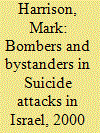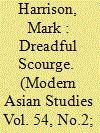|
|
|
Sort Order |
|
|
|
Items / Page
|
|
|
|
|
|
|
| Srl | Item |
| 1 |
ID:
068587


|
|
|
| 2 |
ID:
167556


|
|
|
|
|
| Summary/Abstract |
How many Soviet citizens died because of World War II? A new estimate of the Soviet war dead is 42 million. This figure, from Russian historian Igor’ Ivlev, is at least 15 million more than the 26–27 million previously estimated by Russian demographers Andreev, Darskii and Khar’kova and widely accepted for a quarter of a century. I consider the implications of the two estimates for the Soviet demographic accounts, contrast their sources and methods, and conclude that the new figure lacks substantial foundations. On existing knowledge, the best estimate of Soviet war dead remains 26–27 million.
|
|
|
|
|
|
|
|
|
|
|
|
|
|
|
|
| 3 |
ID:
172009


|
|
|
|
|
| Summary/Abstract |
In 1817–21, the Indian subcontinent was ravaged by a series of epidemics which marked the beginning of what has since become known as the First Cholera Pandemic. Despite their far-reaching consequences, these epidemics have received remarkably little attention and have never been considered as historical subjects in their own right. This article examines the epidemics of 1817–21 in greater detail and assesses their significance for the social and political history of the Indian subcontinent. Additionally, it examines the meanings that were attached to the epidemics in the years running up to the first appearance of cholera in the West. In so doing, the article makes comparisons between responses to cholera in India and in other contexts, and tests the applicability of concepts used in the study of epidemics in the West. It is argued that the official reaction to cholera in India was initially ameliorative, in keeping with the East India Company's response to famines and other supposedly natural disasters. However, this view was gradually supplemented and replaced by a view of cholera as a social disease, requiring preventive action. These views were initially rejected in Britain, but found favour after cholera epidemics in 1831–32. Secondly, in contrast to later epidemics, it is argued that those of 1817–21 did little to exacerbate tensions between rulers and the ruled. On the rare occasions when cholera did elicit a violent reaction, it tended to be intra-communal rather than anti-colonial in nature.
|
|
|
|
|
|
|
|
|
|
|
|
|
|
|
|
| 4 |
ID:
000602


|
|
|
|
|
| Publication |
Cambridge, Cambridge University Press, 1998.
|
| Description |
xxiii, 307p.: fig., table.Hbk
|
| Standard Number |
0521620465
|
|
|
|
|
|
|
|
|
|
|
|
Copies: C:1/I:0,R:0,Q:0
Circulation
| Accession# | Call# | Current Location | Status | Policy | Location |
| 041945 | 940.5314/HAR 041945 | Main | On Shelf | General | |
|
|
|
|
| 5 |
ID:
122794


|
|
|
|
|
| Publication |
2013.
|
| Summary/Abstract |
What does it cost to do business under a dictator? In 1949 the Soviet state had entered its most secretive phase. One of the Gulag's most important secrets was the location of its labour camps. As this secret was guarded more closely, camps found it increasingly difficult to do business without disclosing a state secret: their own location. For months and then years Gulag officials worked around this dilemma, expending considerable efforts. Rather than resolve it, they eventually normalised it. This study of the transaction costs of an autocratic regime raises basic questions about how Soviet secrecy was calibrated.
|
|
|
|
|
|
|
|
|
|
|
|
|
|
|
|
| 6 |
ID:
048117


|
|
|
|
|
| Publication |
Houndmills, Macmillan Press Ltd., 2000.
|
| Description |
xviii, 283p.
|
| Standard Number |
0333727630
|
|
|
|
|
|
|
|
|
|
|
|
Copies: C:1/I:0,R:0,Q:0
Circulation
| Accession# | Call# | Current Location | Status | Policy | Location |
| 042500 | 338.4762330947/BAR 042500 | Main | On Shelf | General | |
|
|
|
|
|
|
|
|
|